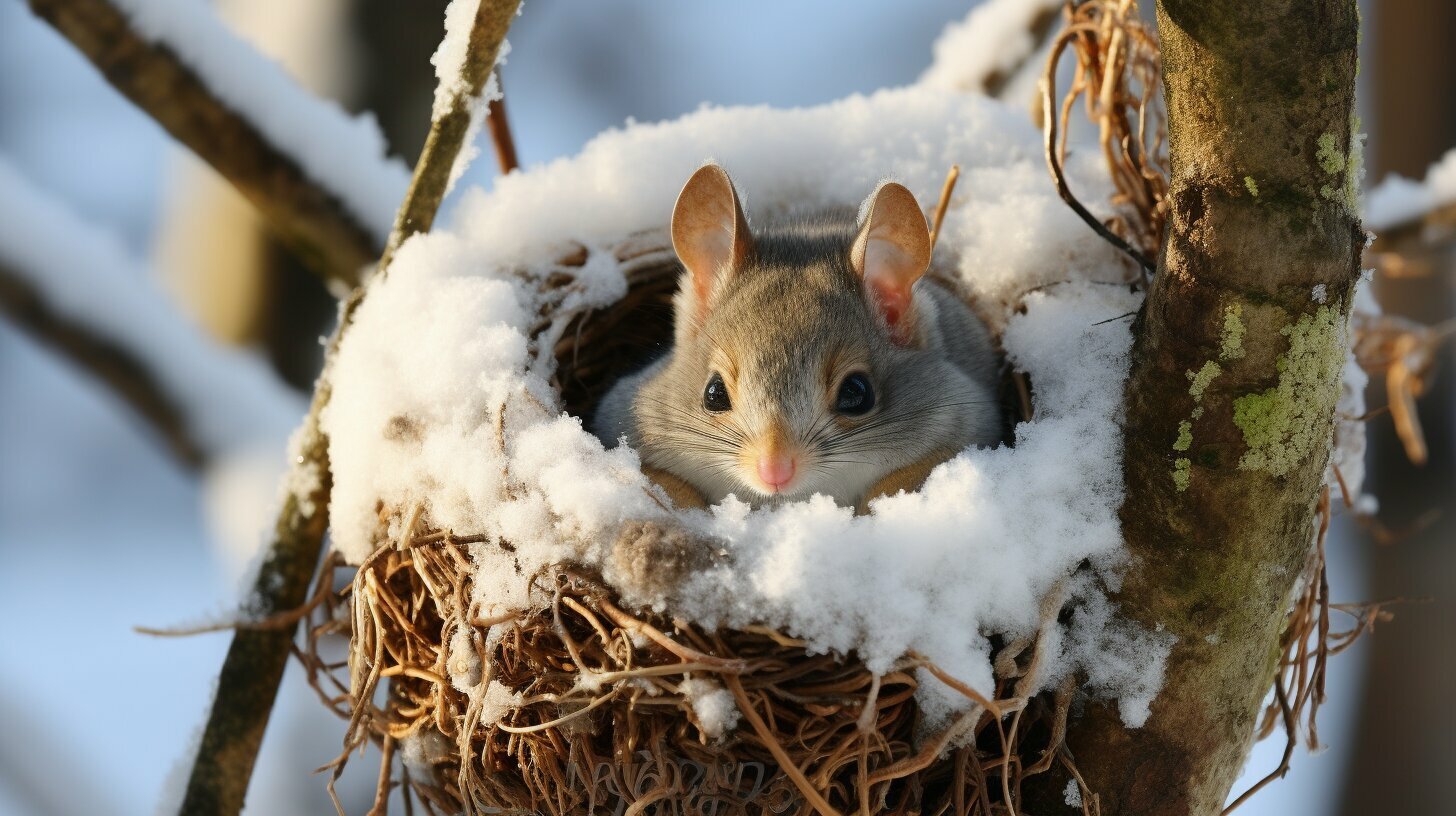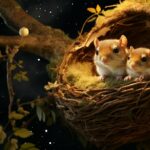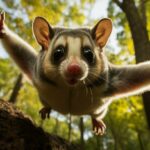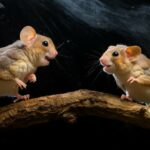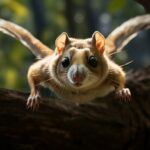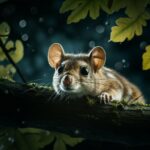Flying squirrels have fascinating winter survival strategies that lead many to wonder if they hibernate. While they don’t hibernate in the traditional sense, these small creatures have unique behaviors to endure the cold season. Let’s explore the hibernation patterns and behaviors of flying squirrels and unveil the secrets of their winter survival.
Key Takeaways:
- Flying squirrels do not hibernate, but they employ winter survival strategies.
- During winter, they lower their metabolic rates and body temperatures to conserve energy.
- They huddle together in groups to keep warm and minimize time spent outside the nest.
- In harsh weather conditions, flying squirrels may seek shelter in homes, potentially causing damage.
- To prevent flying squirrels from entering homes, seal entry points and trim tree limbs.
Understanding Flying Squirrel Winter Survival Strategies
Unlike many other animals, flying squirrels do not go into true hibernation, but they employ unique winter survival strategies. These small and agile creatures have developed fascinating adaptations to endure the harsh winter conditions.
During the winter months, flying squirrels lower their metabolic rates and body temperatures to conserve energy. This state of reduced activity is known as torpor. They enter torpor during the day, spending most of their time inside their nests. By slowing down their metabolism, flying squirrels can save precious energy and maintain their body heat.
One of the remarkable strategies flying squirrels use to stay warm is huddling together in groups. By snuggling close to each other, they share body heat and minimize the amount of time spent outside their nests. This behavior not only helps them stay warm but also fosters social bonding within their group.
| Winter Survival Strategies of Flying Squirrels |
|---|
| Lowering metabolic rates and body temperatures |
| Huddling together in groups for warmth |
| Reducing time spent outside of nests |
However, when winter conditions become exceptionally harsh, flying squirrels may seek shelter in human habitations, such as attics. While this behavior can be problematic for homeowners, it is important to understand that flying squirrels are simply trying to survive. They can cause damage by gnawing on wires and walls, and their waste accumulation can create foul odors. Taking preventive measures, such as sealing all entry points and trimming tree limbs, can help deter them from invading homes.
In conclusion, although flying squirrels do not hibernate like many other animals, they possess remarkable winter survival strategies. By adapting their behavior and conserving energy, these small mammals navigate the challenges of winter and ensure their own survival.
The Winter Habits of Flying Squirrels
Flying squirrels typically begin their hibernation period during late fall or early winter and can remain in this state for several months. While they do not hibernate in the traditional sense, flying squirrels employ unique winter survival strategies to cope with harsh weather conditions. They lower their metabolic rates and body temperatures to conserve energy, allowing them to endure the cold temperatures of winter.
To keep warm, flying squirrels huddle together in groups, often sharing nests and tree cavities. This behavior helps them retain body heat and reduces the amount of time spent outside of the nest. By minimizing their time in the cold, flying squirrels can conserve energy and survive the winter months more effectively.
Despite their adaptations, flying squirrels may still seek shelter in human habitations when weather conditions become too extreme. Attics, in particular, provide a cozy and secure space for them to rest. However, their presence indoors can cause problems. Flying squirrels have a tendency to gnaw on wires and walls, which can lead to electrical issues and structural damage. Additionally, their waste accumulation can create foul odors. To prevent them from entering homes, it is essential to seal all entry points and trim tree limbs that provide access to the building.
Table: Common Winter Habits of Flying Squirrels
| Habit | Description |
|---|---|
| Huddling | Flying squirrels gather in groups to share body heat and stay warm. |
| Reduced activity | They minimize their time outside of nests to conserve energy. |
| Lowered metabolic rate | They decrease their metabolic rates to conserve energy during winter. |
| Seeking shelter | Flying squirrels may invade attics for warmth and protection during severe weather. |
In conclusion, flying squirrels do not hibernate in the traditional sense, but they have developed unique winter survival strategies. By lowering their metabolic rates, huddling together for warmth, and seeking shelter when necessary, they are able to endure the challenges of winter. However, it is important for homeowners to take preventive measures to avoid damage and unwanted encounters with these resourceful creatures.
Flying Squirrels and Human Habitations
When weather conditions become too harsh, flying squirrels may seek shelter in homes and invade attics, leading to potential problems. These adorable creatures, known for their gliding abilities, can cause damage and inconvenience if left unchecked.
If flying squirrels find their way into your home, they can gnaw on wires and walls, posing a fire hazard and structural damage risk. Their waste accumulation can also create foul odors, adding to the discomfort. It is necessary to address these concerns promptly to ensure the safety and integrity of your living space.
To prevent flying squirrel invasions, it is crucial to seal all entry points that could provide them access to your home. Carefully inspect your roof, walls, and attic for any gaps, cracks, or openings. Trim tree limbs that may be too close to your house, as they can serve as bridges for these nimble creatures.
By taking proactive measures and securing your dwelling, you can protect both your property and the well-being of flying squirrels. Let’s coexist harmoniously with these fascinating creatures while keeping our homes safe and comfortable for ourselves and our furry friends.
Conclusion
Flying squirrels’ ability to lower their metabolic rates and body temperatures during the winter allows them to survive harsh conditions without true hibernation.
Instead of going into a deep sleep like traditional hibernators, flying squirrels enter a state called torpor. During torpor, their metabolic rates drop significantly, and their body temperatures decrease to conserve energy.
To stay warm and reduce their time spent outside of their nests, flying squirrels huddle together in groups. This cooperative behavior helps them maintain body heat and endure the cold winter nights.
However, when weather conditions become too extreme, flying squirrels may seek shelter in human habitations, including attics. While they may seem cute and harmless, these furry creatures can cause damage by gnawing on wires and walls. Additionally, their waste accumulation can create foul odors.
To prevent flying squirrels from entering your home, it is important to seal all entry points and trim tree limbs that could serve as bridges to your house. By taking these precautions, you can coexist peacefully with these fascinating creatures while keeping your home safe and intact.
Can Flying Squirrels Help Keep Deer Away?
Can squirrels serve as a natural deer deterrent? Some believe so. Flying squirrels, specifically, can prove helpful in keeping deer at bay. These nocturnal creatures are known for their ability to glide from tree to tree silently. Therefore, squirrels as natural deer deterrent may have the potential to deter deer from entering gardens or yards due to their unexpected presence and quick movements.
FAQ
Q: Do flying squirrels hibernate?
A: No, flying squirrels do not hibernate in the traditional sense. Instead, they lower their metabolic rates and body temperatures to conserve energy during the winter.
Q: How do flying squirrels survive in the winter?
A: Flying squirrels employ various survival strategies during the winter months. They lower their metabolic rates and body temperatures, enter a state of torpor, and huddle together in groups to keep warm.
Q: Do flying squirrels seek shelter in homes during winter?
A: Yes, flying squirrels may seek shelter in homes during harsh weather conditions. They can invade attics and cause damage by gnawing on wires and walls. They also create foul odors from waste accumulation.
Q: How can I prevent flying squirrels from entering my home?
A: It is important to seal all entry points, such as cracks and openings, to prevent flying squirrels from entering homes. Additionally, trimming tree limbs near your home can discourage them from accessing your attic.

